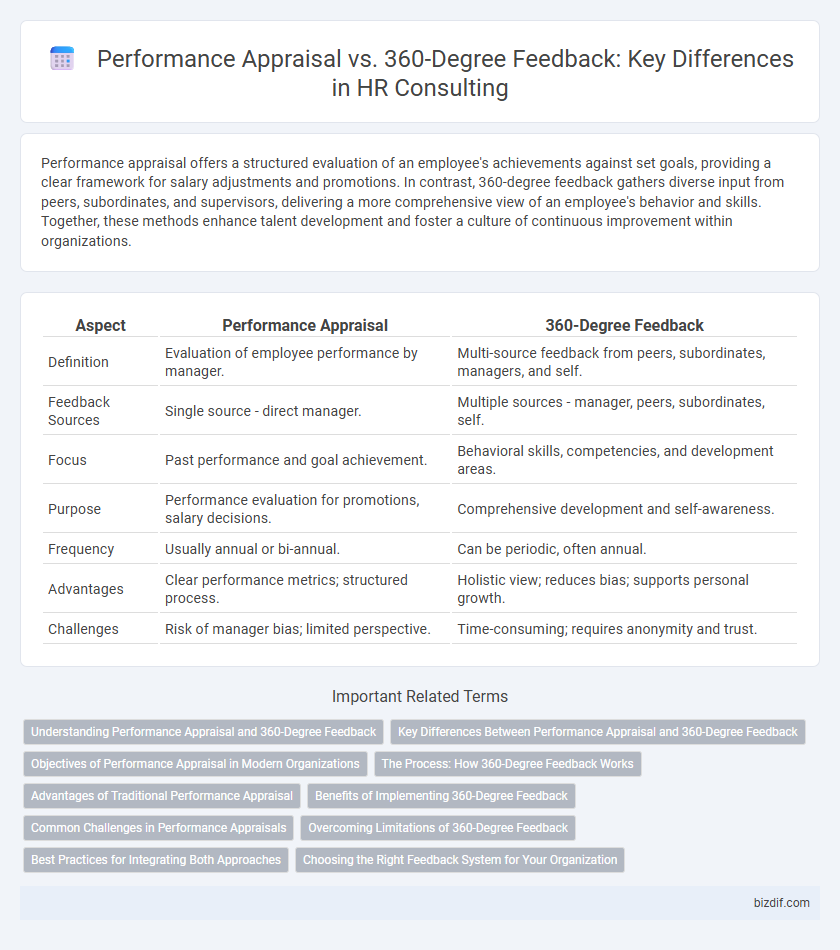Performance appraisal offers a structured evaluation of an employee's achievements against set goals, providing a clear framework for salary adjustments and promotions. In contrast, 360-degree feedback gathers diverse input from peers, subordinates, and supervisors, delivering a more comprehensive view of an employee's behavior and skills. Together, these methods enhance talent development and foster a culture of continuous improvement within organizations.
Table of Comparison
| Aspect | Performance Appraisal | 360-Degree Feedback |
|---|---|---|
| Definition | Evaluation of employee performance by manager. | Multi-source feedback from peers, subordinates, managers, and self. |
| Feedback Sources | Single source - direct manager. | Multiple sources - manager, peers, subordinates, self. |
| Focus | Past performance and goal achievement. | Behavioral skills, competencies, and development areas. |
| Purpose | Performance evaluation for promotions, salary decisions. | Comprehensive development and self-awareness. |
| Frequency | Usually annual or bi-annual. | Can be periodic, often annual. |
| Advantages | Clear performance metrics; structured process. | Holistic view; reduces bias; supports personal growth. |
| Challenges | Risk of manager bias; limited perspective. | Time-consuming; requires anonymity and trust. |
Understanding Performance Appraisal and 360-Degree Feedback
Performance appraisal is a systematic evaluation process where managers assess an employee's job performance based on predefined criteria and goals, providing a structured review typically focused on individual achievements and improvement areas. In contrast, 360-degree feedback incorporates input from a range of sources including peers, subordinates, supervisors, and sometimes clients, offering a comprehensive perspective on an employee's behaviors, skills, and impact within the organization. Understanding these methods enables HR professionals to select and implement performance management tools that foster employee development, enhance communication, and align with organizational objectives.
Key Differences Between Performance Appraisal and 360-Degree Feedback
Performance appraisal primarily involves evaluation by a direct supervisor, focusing on individual job performance against specific goals and metrics, while 360-degree feedback gathers insights from multiple sources including peers, subordinates, and self-assessment, providing a holistic view of employee behavior and competencies. Performance appraisal is formal and often tied to compensation decisions, whereas 360-degree feedback emphasizes developmental feedback and personal growth. The key difference lies in the scope and perspective of feedback, with performance appraisals being top-down and 360-degree feedback fostering multi-source evaluations.
Objectives of Performance Appraisal in Modern Organizations
Performance appraisal in modern organizations centers on enhancing employee productivity, aligning individual goals with business objectives, and identifying development opportunities. It provides structured feedback to support career growth and improve performance through measurable criteria and standardized evaluations. This process fosters accountability and drives organizational effectiveness by systematically assessing contributions and potential.
The Process: How 360-Degree Feedback Works
360-Degree Feedback involves collecting performance evaluations from multiple sources, including supervisors, peers, subordinates, and sometimes clients, to provide a comprehensive view of an employee's strengths and areas for improvement. This process typically starts with self-assessment, followed by anonymous questionnaires distributed to selected raters, ensuring diverse perspectives are captured. Feedback is then compiled into detailed reports that highlight patterns and guide personalized development plans, enhancing accuracy and holistic understanding compared to traditional performance appraisals.
Advantages of Traditional Performance Appraisal
Traditional performance appraisal offers clear, structured evaluations focused on individual goals and job responsibilities, ensuring straightforward metrics for employee development and compensation decisions. It provides managers with direct oversight and accountability, simplifying performance tracking and facilitating consistent feedback. The process allows for easy documentation and legal compliance, making it a reliable tool for organizations aiming for standardized performance reviews.
Benefits of Implementing 360-Degree Feedback
Implementing 360-degree feedback enhances employee development through comprehensive evaluations from peers, supervisors, and subordinates, providing diverse perspectives that traditional performance appraisals often miss. This multi-source feedback fosters self-awareness, encourages open communication, and identifies skill gaps more effectively, leading to targeted training and improved performance. Organizations that adopt 360-degree feedback experience increased employee engagement, higher accountability, and stronger leadership capabilities across all levels.
Common Challenges in Performance Appraisals
Performance appraisals often face challenges such as bias, inconsistent evaluation criteria, and inadequate feedback quality, which can undermine employee development and organizational goals. Unlike 360-degree feedback, which incorporates diverse perspectives from peers, subordinates, and supervisors, traditional appraisals may lack comprehensive insights, leading to inaccurate performance assessments. Addressing these common pitfalls requires structured training for evaluators and the integration of multi-source feedback systems to enhance objectivity and actionable outcomes.
Overcoming Limitations of 360-Degree Feedback
Overcoming limitations of 360-degree feedback involves enhancing anonymity and ensuring actionable insights to improve employee development. Integrating technology platforms can streamline feedback collection and analysis, reducing biases and increasing transparency in performance evaluations. Combining 360-degree feedback with targeted coaching empowers HR professionals to address gaps effectively and foster continuous growth.
Best Practices for Integrating Both Approaches
Integrating Performance Appraisal with 360-Degree Feedback enhances employee development by combining objective goal assessments and comprehensive multi-source evaluations. Best practices include aligning feedback criteria with organizational goals, training evaluators for consistency, and ensuring continuous, transparent communication between managers and employees. Leveraging technology platforms to aggregate data and track progress promotes actionable insights and supports a culture of ongoing performance improvement.
Choosing the Right Feedback System for Your Organization
Performance appraisal offers a structured evaluation focusing on individual goals and competencies, while 360-degree feedback incorporates diverse perspectives from peers, subordinates, and supervisors to provide a holistic view. Selecting the right feedback system depends on organizational culture, leadership style, and development objectives to ensure accurate performance insights and employee engagement. Integrating data analytics with qualitative feedback enhances decision-making and aligns performance management with strategic goals.
Performance Appraisal vs 360-Degree Feedback Infographic

 bizdif.com
bizdif.com